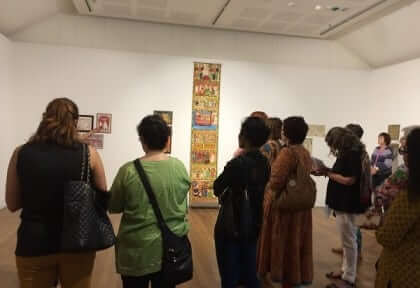An art exhibition, Bapu: the Craftsperson’s Vision, shares Gandhi’s message through the fabric of Khadi
Art lovers in Queensland were treated to a taste of India’s crafts through a recent exhibit titled ‘Bapu: the Craftsperson’s Vision’. Held at Frank Moran Gallery at the Queensland University of Technology the showcase was a part of the Confluence Festival of India in Australia.

“The vision of ‘Bapu: the Craftsperson’s Vision’ came to me in a dream; it took me a year to work with craftspersons from across India to translate into reality,” said curator Sunaina Suneja. “I wanted this exhibit to reflect the life of Mahatma Gandhi and his teachings on different textures of Khadi.”
Sunaina’s love for the Khadi fabric began when she read the autobiography of Mahatma Gandhi in the early 1980s.

“Not everybody can boast of a national fabric like Khadi,” she explains. The weft and weave of Khadi is inextricably linked with India’s history and development.
After working with the Khadi fabric for years, Sunaina realised there are autobiographies, theatre productions, movies, books and more reflecting Mahatma Gandhi, but none in this skilful art form.

She asked various craftspersons to depict what Gandhi meant to them; some were inspired by their Gandhian knowledge, whilst others needed stories from his life.
“Bapu has travelled to Australia, and Bapu brought me to Brisbane,” smiled Sunaina.

Indeed, Bapu’s journey through art transported brought the stories of history books alive whilst spinning a contemporary twist. Sunaina went around the room explaining each artistic technique and the meaning or reflection from Gandhi’s life.
From different corners of India we experienced Warli Art, tribal art from Maharashtra, using basic geometric designs including shapes like triangles and circles.
The Warli paintings depict Gandhi’s life through the eyes of an individual craftsperson; from his education in India and then London, his journey to South Africa and his fight for freedom as Mahatma. The Dandi March and the burning of foreign goods (Swaraj) beautifully draws out the history in front of our eyes. The final panel of the Warli paintings was made much later to commemorate freedom in 1947.

“These Warli painting panels were discovered in 2012 by a children’s book publisher and later printed in My Gandhi Story,” said Sunaina.
As she took us around the room, Sunaina talked about each of the art forms and their origins: Sanjhi stencil art (Mathura); Patachitra, paintings done on cloth (Gujarat, Orissa, Rajasthan); Chikankari, elegant fine work (Lucknow); Madhubani, a form of painting (Bihar); Kantha, straight stitch embroidery (West Bengal); Bandhini, or tie-dye (Gujarat and Rajasthan); Phulkari, embroidery with colourful silk threads (Punjab); and Gond and Bhil art, tribal art transposed on paper and cloth, and applique work.

The art displayed laid emphasis on various teaching aspects of Gandhi, including his focus on cleanliness, exercising for good health, and the importance of a girl child.
A visitor to the exhibit, Gail P. told me that she was glad her daughter informed her about the collection. “I am just simply absorbed, so pleased to be here.”
Whilst for Indian-born Alisha Tromp, “This has been a fantastic journey down memory lane of Bapu’s contribution to Indian independence, creatively displayed by the aspiring artists of India.”
A seamless exhibit showcasing India’s best craft, with a common theme, Mahatma Gandhi.




